|
|
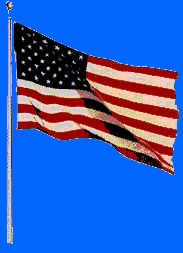
|
of the United States of America,
and to the Republic for which it stands,
one nation under God, indivisible,
with liberty and justice for all."
|
|
On September 8,1892, the Boston based magazine "The Youth's Companion" published a few words for students to repeat on Columbus Day that year. Written by Francis Bellamy, the circulation manager and native of Rome, New York, and reprinted on thousands of leaflets, the words were sent out to public schools across the country. On October 12, 1892, the quadricentennial of Columbus' arrival, more than 12 million children recited the Pledge of Allegiance, thus beginning a required school-day ritual.
At the first National Flag Conference in Washington D.C., on June 14, 1923, a change was made. For clarity, the words "the Flag of the United States" replaced "my flag". In the following years, various other changes were suggested but were never formally adopted. It was not until 1942 that Congress officially recognized the Pledge of Allegiance. One year later, in June 1943, the Supreme Court ruled that school children could not be forced to recite it. In fact, today only half of our fifty states have laws that encourage the recitation of the Pledge of Allegiance in the classroom.
In June of 1954 an amendment was made to add the words "under God". Then-President Dwight D. Eisenhower said "In this way we are reaffirming the transcendence of religious faith in America's heritage and future; in this way we shall constantly strengthen those spiritual weapons which forever will be our country's most powerful resource in peace and war."
|
|
The American flag is universally recognized as the ultimate symbol of our freedoms and liberties. It can be flown at half-staff to signify mourning for the death of a national or state official, upside down as a signal of distress and virtually anywhere as a symbol of national pride. But while everyone recognizes the flag, few realize the evolution of its design.
The Stars and Stripes originated from a resolution adopted by the Second Continental Congress on June 14, 1777, which stated that the flag of the United States must be thirteen stripes, alternate red and white, and that the union be thirteen stars, white in a blue field, representing a new constellation. The new flag was to replace the disparate array of flags created by different colonies of settlers.
The resolution gave no further instruction and as a result, some flags had stars scattered on the blue field without any design, while others had the stars in rows or in a circle. Also, some stars had six points while others had eight.
With the addition of two new states to the union in 1791 and 1792, a resolution was adopted to expand the flag to 15 stars and stripes. This was the official American flag from 1795 to 1818, inspiring Francis Scott key to write "The Star-Spangled Banner."
Realizing that the flag would become unwieldy with a stripe added for each new state, Navy Captain Samuel Reid proposed that the stripes remain 13, to represent the thirteen original states, while a new star be added for each State entering the Union. In 1818, President Monroe accepted the bill for a flag which contained 20 stars and a provision to allow a star for each new state, to be added July 4 following its admission into the Union.
Eventually, the growth of the nation resulted in a flag with 48 stars after the admission of Arizona and New Mexico in 1912 and finally 50 stars with the admission of Alaska in 1959 and Hawaii in 1960. The 50 stars prompted a final redesign, signed into law in 1959 and effective on July 4, 1960.
The flag was described by President Woodrow Wilson as "an emblem of our unity, thought and purpose as a nation...with no other character than that which we give it from generation to generation."
|
|
 American ships in New England waters flew a "Liberty Tree" flag in 1775. It shows a green pine tree on a white background.
American ships in New England waters flew a "Liberty Tree" flag in 1775. It shows a green pine tree on a white background.
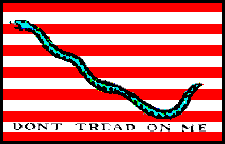 The Continental Navy used this flag upon its inception.
The Continental Navy used this flag upon its inception.
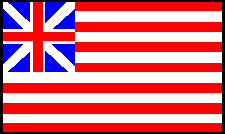 The "Grand Union" shown here is also called The "Cambridge Flag." It was flown over Prospect Hill, overlooking Boston, January 1, 1776. In the canton (the square in the corner) are the crosses of Saint Andrew and Saint George, borrowed from the British flag.
The "Grand Union" shown here is also called The "Cambridge Flag." It was flown over Prospect Hill, overlooking Boston, January 1, 1776. In the canton (the square in the corner) are the crosses of Saint Andrew and Saint George, borrowed from the British flag.
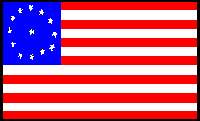 According to some sources, this flag was first used in 1777. It was used by the Third Maryland Regiment. There was no official pattern for how the stars were to be arranged. The flag was carried at the Battle of Cowpens, which took place on January 17, 1781, in South Carolina. The actual flag from that battle hangs in the Maryland State House.
According to some sources, this flag was first used in 1777. It was used by the Third Maryland Regiment. There was no official pattern for how the stars were to be arranged. The flag was carried at the Battle of Cowpens, which took place on January 17, 1781, in South Carolina. The actual flag from that battle hangs in the Maryland State House.
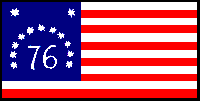 At the Battle of Bennington in August 1777 were two famous flags. One, shown here, is called the Bennington Flag or the Fillmore Flag. Nathaniel Fillmore took this flag home from the battlefield. The flag was passed down through generations of Fillmores, including Millard, and today it can be seen at Vermont's Bennington Museum. The other (not pictured) has a green field and a blue canton with 13 gold-painted stars arranged in rows. General John Stark gave his New Hampshire troops a rallying speech that would be the envy of any football coach today. He said, "My men, yonder are the Hessians. They were brought for seven pounds and ten pence a man. Are you worth more? Prove it. Tonight, the American flag floats from yonder hill or Molly Stark sleeps a widow!"
At the Battle of Bennington in August 1777 were two famous flags. One, shown here, is called the Bennington Flag or the Fillmore Flag. Nathaniel Fillmore took this flag home from the battlefield. The flag was passed down through generations of Fillmores, including Millard, and today it can be seen at Vermont's Bennington Museum. The other (not pictured) has a green field and a blue canton with 13 gold-painted stars arranged in rows. General John Stark gave his New Hampshire troops a rallying speech that would be the envy of any football coach today. He said, "My men, yonder are the Hessians. They were brought for seven pounds and ten pence a man. Are you worth more? Prove it. Tonight, the American flag floats from yonder hill or Molly Stark sleeps a widow!"
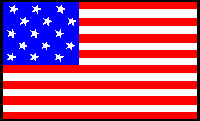 Vermont and Kentucky joined the union in 1791 and 1792. This flag with 15 stars and 15 stripes, was adopted by a Congressional act of 1794. The flag became effective May 1, 1795.
Vermont and Kentucky joined the union in 1791 and 1792. This flag with 15 stars and 15 stripes, was adopted by a Congressional act of 1794. The flag became effective May 1, 1795.
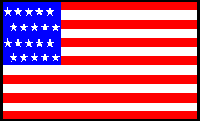 By 1818, the union consisted of 20 states. A Congressional act mandated that the number of stripes be fixed at 13 and that one new star was to be added for each new state, the July 4 following its admission. However, nothing was written about what arrangement the stars should be in. This and the following two flags were all used simultaneously.
By 1818, the union consisted of 20 states. A Congressional act mandated that the number of stripes be fixed at 13 and that one new star was to be added for each new state, the July 4 following its admission. However, nothing was written about what arrangement the stars should be in. This and the following two flags were all used simultaneously.
 Another 1818 flag (see above).
Another 1818 flag (see above).
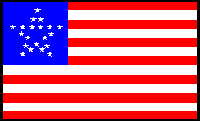 And another 1818 flag (see above). This was called the "Grand Star" flag.
And another 1818 flag (see above). This was called the "Grand Star" flag.
 Following the Mexican-American War in 1846, the nation had 28 states.
Following the Mexican-American War in 1846, the nation had 28 states.
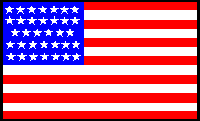 By 1861, the nation had 34 states. Even after the South seceded from the Union, President Lincoln would not allow any stars to be removed from the flag.
By 1861, the nation had 34 states. Even after the South seceded from the Union, President Lincoln would not allow any stars to be removed from the flag.
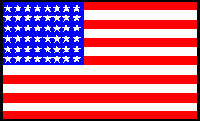 In 1912, the United States had 48 states. It's interesting to note that there was no official design for the 46-star flag used from 1908 to 1912. A Presidential order was issued fixing the position of the stars for this flag. Presidential orders followed the adoption of the flags of 1959 and 1960, as well.
In 1912, the United States had 48 states. It's interesting to note that there was no official design for the 46-star flag used from 1908 to 1912. A Presidential order was issued fixing the position of the stars for this flag. Presidential orders followed the adoption of the flags of 1959 and 1960, as well.
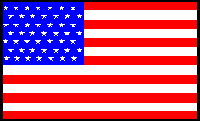 This flag was used in 1959 after the admission of Alaska, but before Hawaii entered the Union in 1960.
This flag was used in 1959 after the admission of Alaska, but before Hawaii entered the Union in 1960.
 The United States flag today.
The United States flag today.
|
|
|
Sweet land of liberty, Of thee I sing; Land where my father died , Land of the Pilgrims' pride; From every mountain side, Let freedom ring.
My native country, thee-
Let music swell the breeze,
Our father's God, to thee, |

Get your own Free Home Page